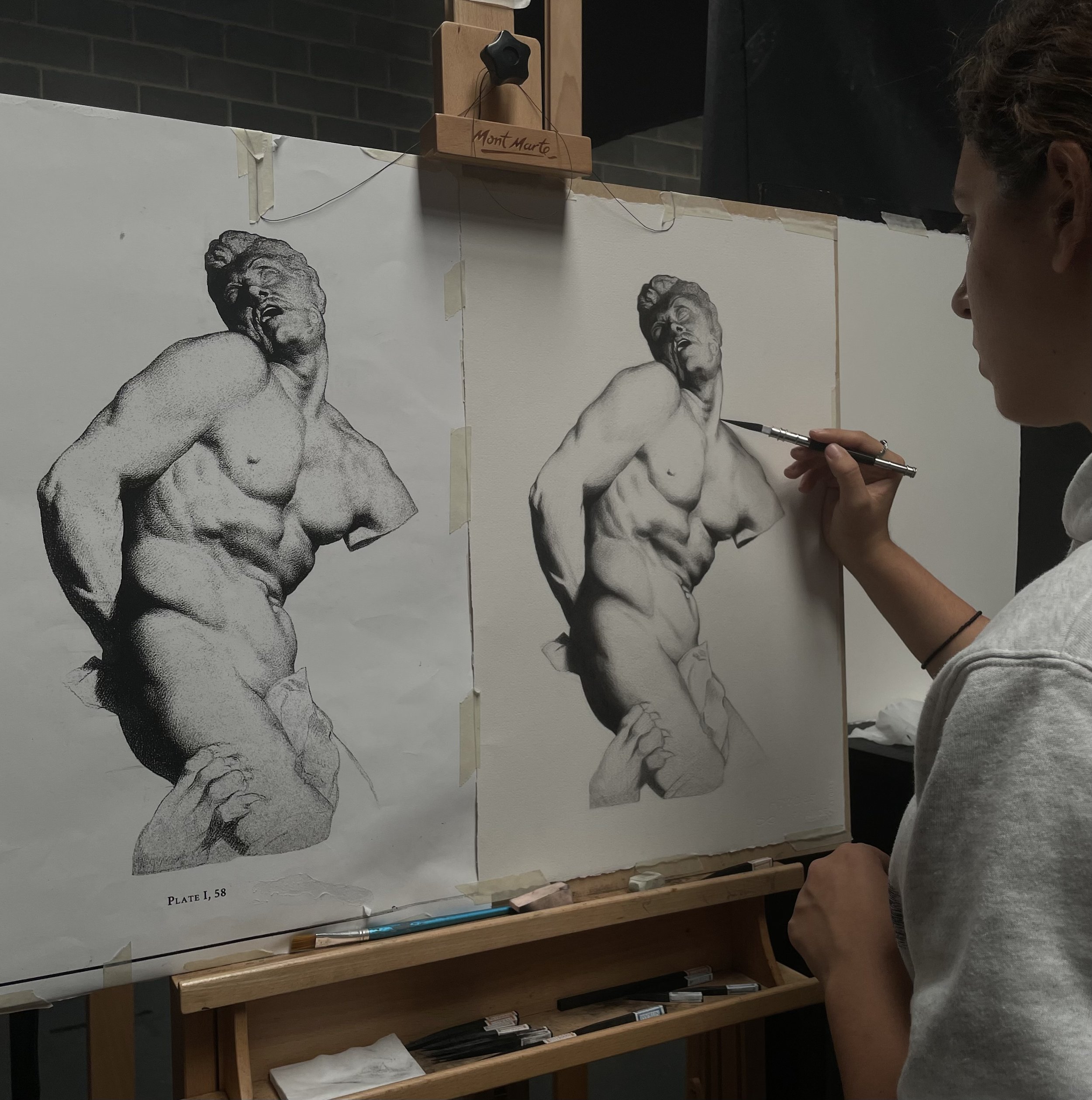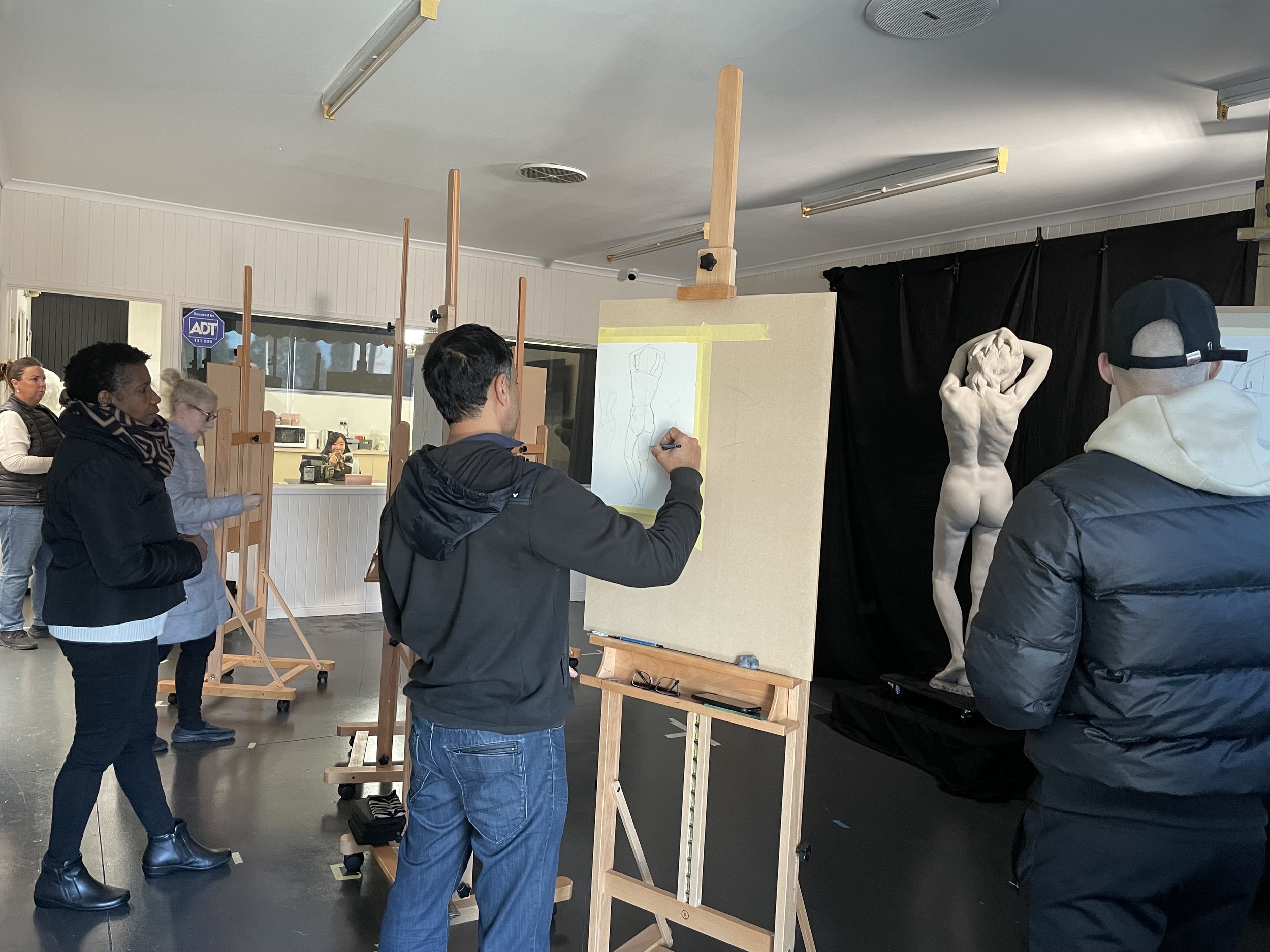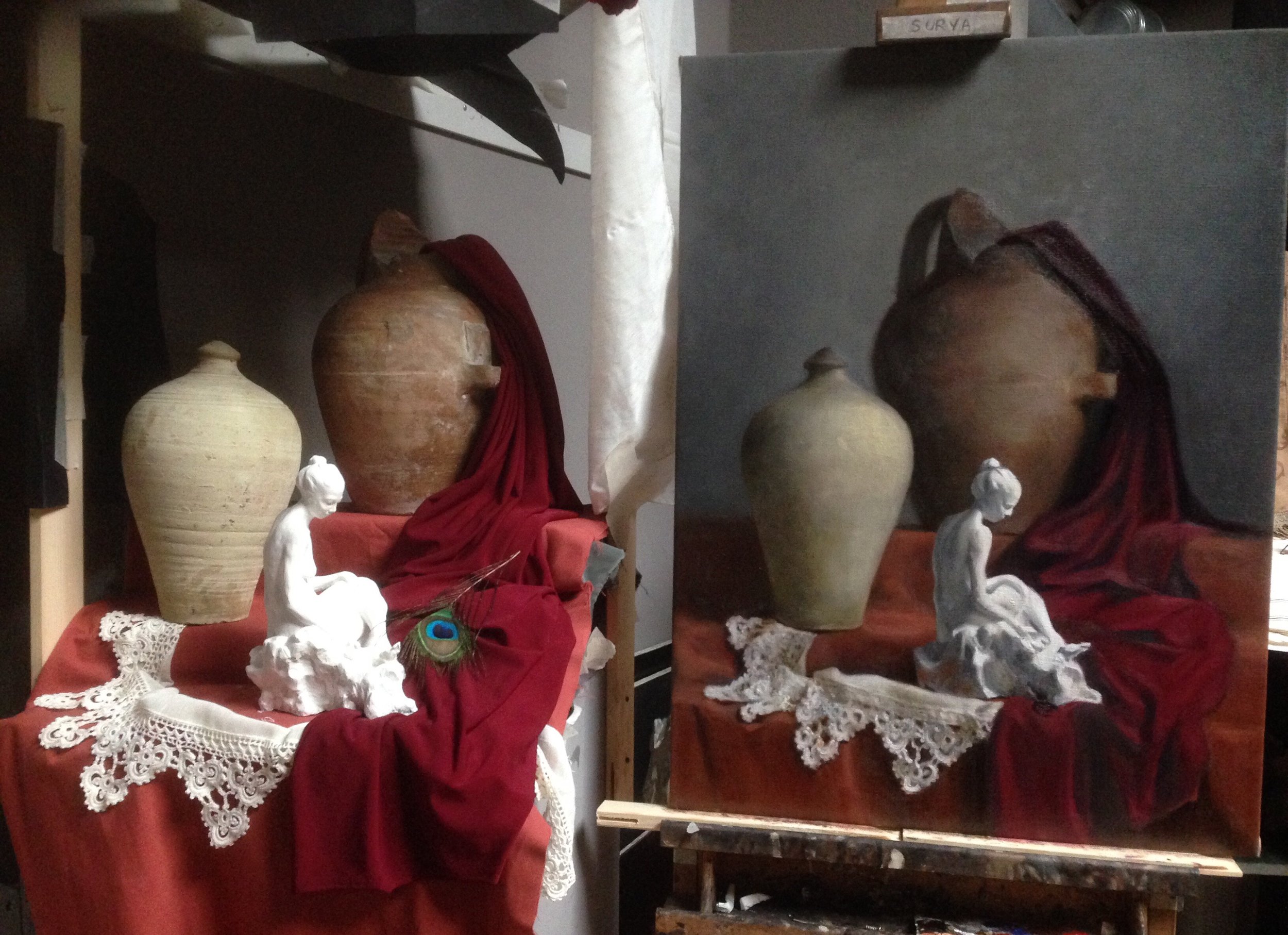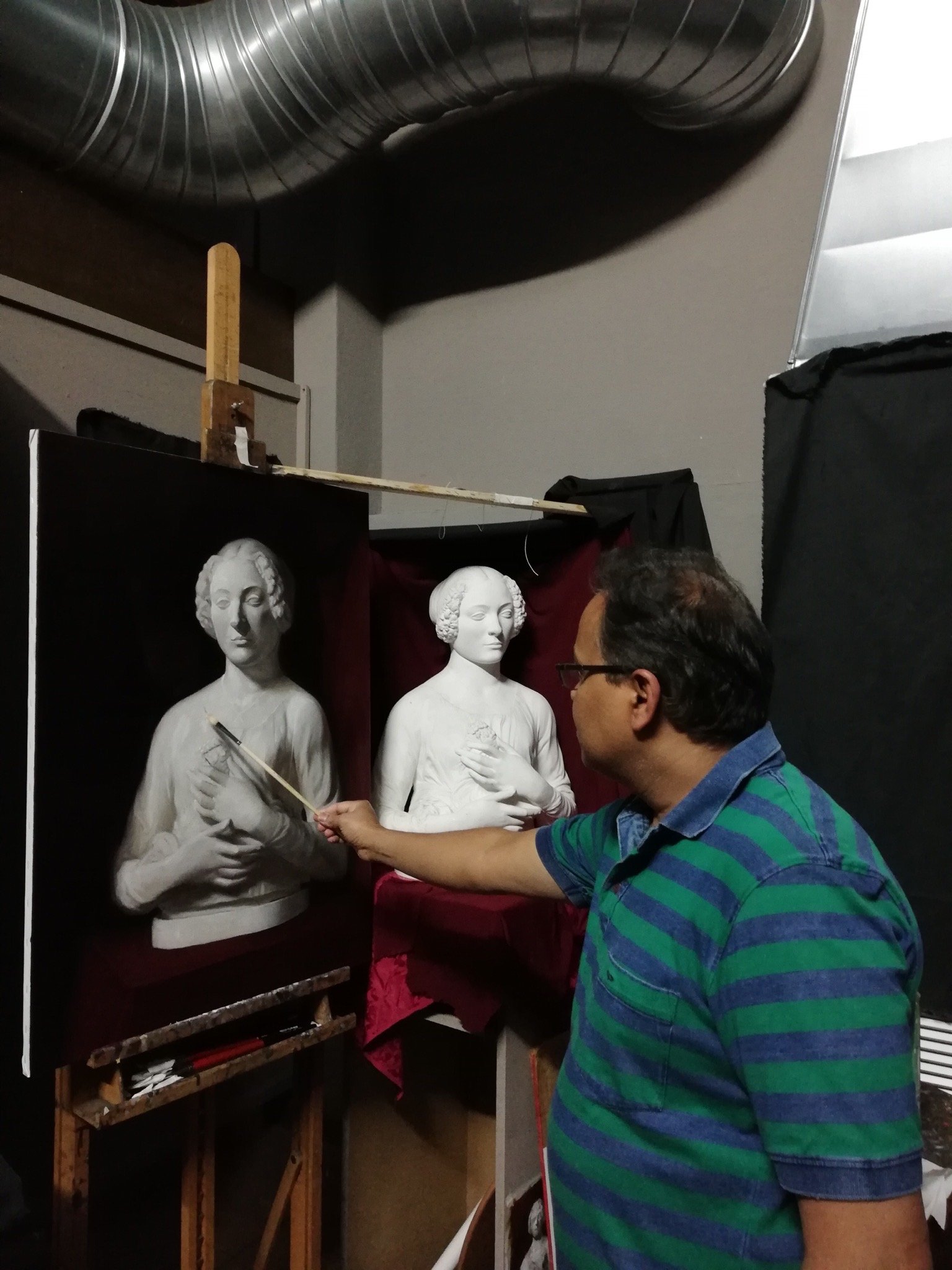
Drawing and Painting Program
Curriculum
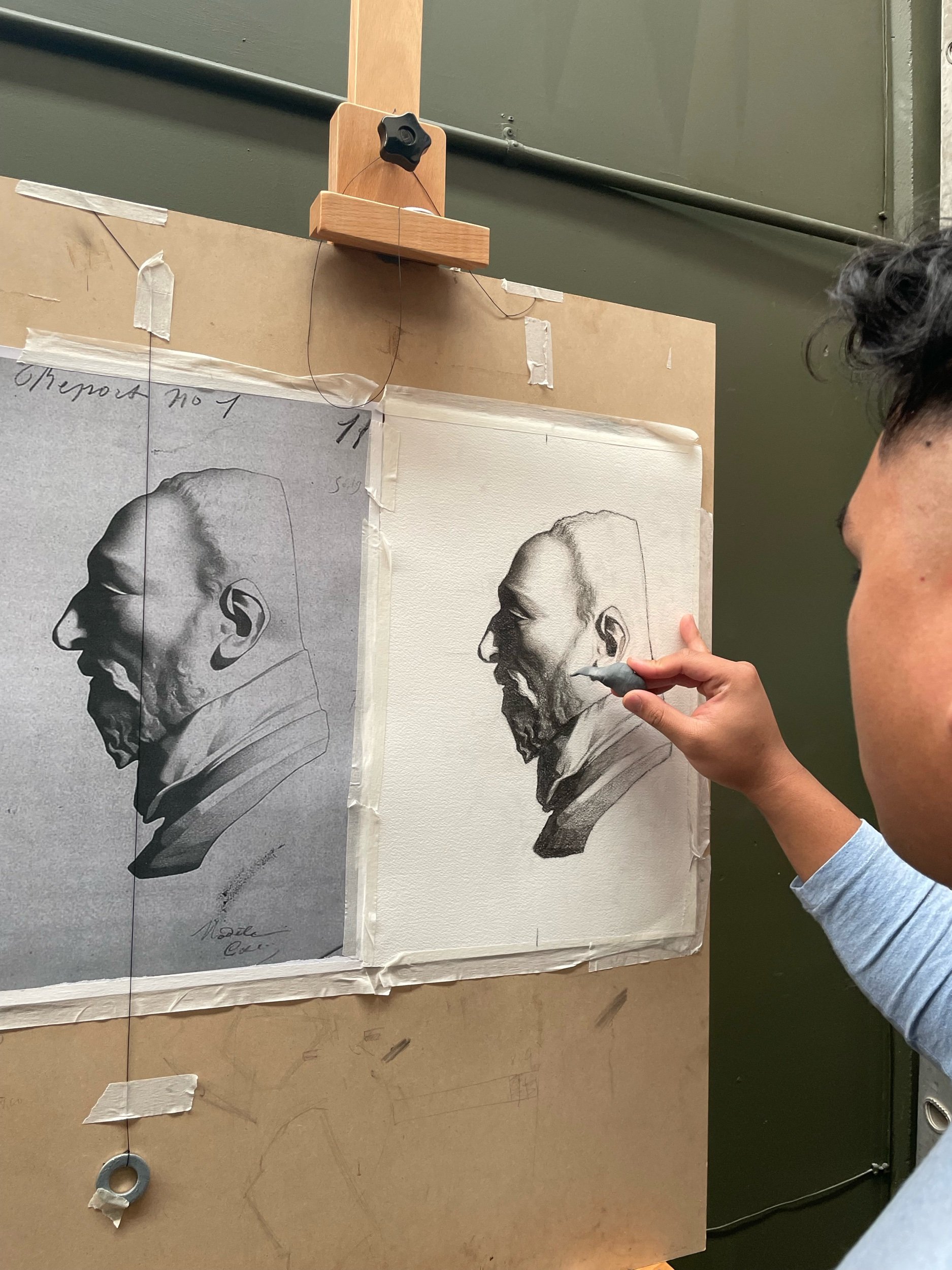
Beginner Intensive drawing (Level-1)
Beginner Drawing, Lev-1
A structured set of exercises focuses on outline, proportion, and shadow shape, on a step by step method through an established program. The first exercises are designed to strengthen the student’s visual relationship with two-dimensional form to help them confront three-dimensional subjects in life. The simplified forms of the Bargue Drawings allow students to learn the procedure very well, and develop skill in reproducing the outline, blocking out shapes, and refining line quality. They also begin to understand the importance of values in turning form. Students start the foundational skills by learning, how to see their subject, and gain precision through practice and skill in handling their materials and tools. Students are required to copy small Bargue drawings in pencil and large in charcoal from simple to complex exercises. This requires training of the eye to see their shapes correctly, apply the sight size method correctly with a fully controlled technique.
Beginning Drawing program teaches the student to:
Apply the correct procedure to drawing
Apply the sight-size method of measurement in order to view the subject accurately and create an accurate outline
Translate 2D form accurately as stepping stone towards representing nature
Draw correct values
Understand a clear process to draw precisely
Beginner Cast Drawing, Lev-1
Cast drawing uses the skills developed from the Bargue Drawing exercises, and prepares the student’s eye to understand the light and values found in nature. Cast Drawing is the starting point to train the eye to see and translate nature precisely.
Students continue their studies by making copies of casts of classical and Renaissance sculptures. The white surface of the casts allows the student to study and translate the forms and learn about the complexity of values and textures in a simple manner. Importance is given to find the design of shapes and edges and representing through line, mass and values. Students are encouraged to setup with evident shadow shapes and form an interesting composition embracing the nature. Compression of values is taught to help in working with the limitation of medium we have in comparison to nature.
By the completion of Beginning Cast Drawing student will be able to:
Apply the sight-size method of measurement in order to view and reproduce the subject accurately
Compress values
Translate three-dimensional form onto a two dimensional plane
Determine a Focal Point and represent it effectively
Create the impression of depth, distance, and atmosphere among different areas of the drawing
Beginner Figure Drawing, Lev-1
The figure drawing is an important skill for any classical artist to develop. The drawing of the human figure has been an essential part of the study program in the 19th century ateliers. AMAA embraces the mind set and uses life drawing program to push our student’s technical boundaries helping them to find creative ways to approach such a complex subject. Students work under south facing natural light and artificial lights with specific daylight settings. They start from life size casts and later on move to drawing from live models. Correct proportion, body type, and gesture of the model are three critical key points to represent in a life drawing process.
Students start with Life drawing classes in pencil. Pencil drawing reinforces the importance of learning to reproduce the subject’s outline and shadow line accurately. Initially starting with a linear approach of outline, shadow edges, shapes and later followed with the help of anatomical knowledge, to create a sense of weight and balance. Students are taught to draw by working out the transitions in the edges in order to make the forms turn, and create a sense of atmosphere and three dimensions.
Students continue on to use Charcoal as a medium and then address values in their drawings and key them to what they see in nature. By relating the values of the figure to the values in the background, the student gives a sense of space and atmosphere within the pictorial plane.
Beginning Figure Drawing teaches the student to:
Demonstrate an understanding of human anatomy by a sophisticated outline and well designed shadow family vs light family shapes with correct proportions.
Create edges that give the impression of form turning in space
Create a realistic impression of weight and balance
Create a realistic impression of structure and solidity and light flowing over the form
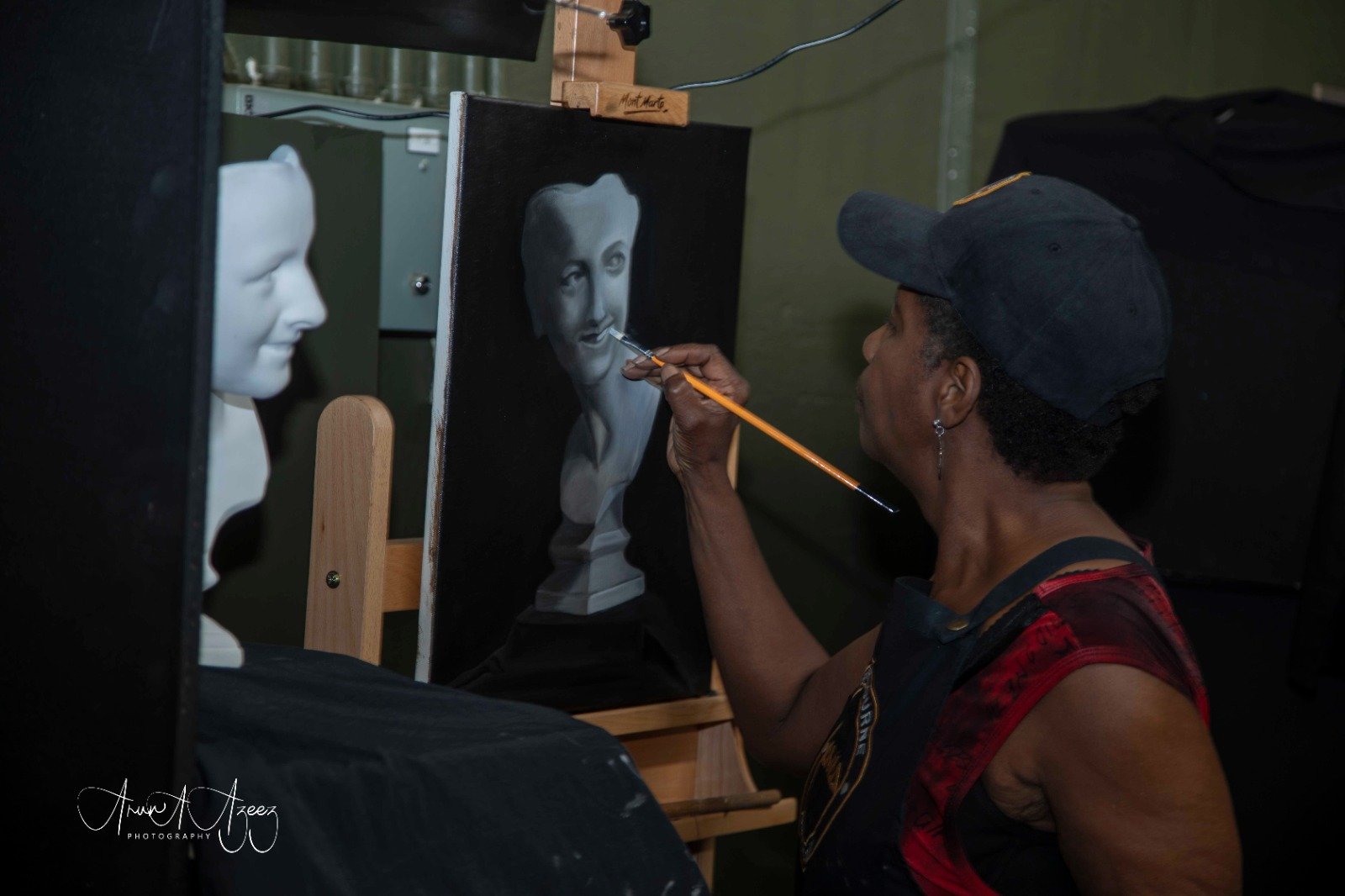
Intermediate Drawing and Painting (Level-2)
Advanced Cast Drawing, Lev-2
Advanced Cast Drawing in charcoal reinforces the principles presented in Beginning Cast Drawing and introduces the added challenge of toned paper and white chalk. The first cast will be mask or simple head, with the purpose of introducing the student to a complex approach to value relationships presented by the addition of white chalk and toned ground. The level of difficulty of the second cast is considered complex.
By starting the drawing on a middle tone and being discouraged from mixing charcoal with white chalk in order to utilize the tone of the paper, the student is challenged to see and organize value relationships with more sophistication and strategy. As the student’s drawing progresses, emphasis is placed on seeing specific half tone shapes and properly compressing them within their value group, in order to achieve a unified and structured drawing.
In order to pass these exercises, the student must correctly draw the subject’s outline, proportion and shadow shape, and display a skillful use of the materials. The instructor also looks for a strong impression of light, accuracy in measurement and values, as well as an achieved sense of form turning in space.
By the conclusion of Advanced Cast Drawing student will be able to:
Apply the sight-size method and comparative size measurement in order to view and reproduce the cast accurately
Demonstrate an ability to compress and organize complex value relationships
Create the impression of depth, distance, and atmosphere among parts of the drawing
Create a realistic impression of structure and solidity Create a realistic impression of light flowing over form
Beginner Painting, Lev-2
In the beginners painting program the student learns to reproduce the values learned in charcoal drawing but using paint as a medium. Students will paint three casts starting from Feature cast as an introduction, continuing to paint a second cast of Mask or Head and finally a Complex cast with a an introduction of colour as a background.
Monochromatic painting (Grisaille), is a fundamental step to painting in a naturalistic way. This course continues the study of plaster casts and serves as an introduction to the medium of oil paint. The student begins to paint the plaster cast in grisaille, using black, raw umber, and white (Limited Palette). Tonal painting builds on the grisailles, introducing color and temperature in a way that simplifies color relationships and paint handling. With as few as three colors, the surprising range of a limited palette serves as a simplified base to explore the ever-expanding range of values and chromatic complexness.
As a beginner in oil painting, most students have difficulty controlling paint either mixing correct values or applying effectively. Students are introduced to painting techniques. AMAA teacher demonstrates about the canvas preparation, paint mixing values in neutral, cool and warm scales. Teacher demonstrates various paint application methods like, scumbling, dabbing, blending, impasto, thick over thin and glazing methods. Students continue to paint three casts with the third cast as a complex with addition of Yellow Ochre and any primary colour to their palette (Intermediate Palette) in accordance to their compositions of the background color. Upon completion of Cast painting the student is introduced to full palette to paint a Pear fruit
By the conclusion of Beginning Painting student will be able to:
Successfully apply drawing skills to the painting medium technique
Correctly transpose the subject’s outline, proportion and shadow shape
Skillful use of materials (oil and canvas)
Achieve a sense of reality using values and temperature when working in limited and intermediate palette
Produce accurate color-values, drawing, sense of light, atmosphere and space.
Advanced Figure Drawing, Lev-2
The figure drawing from life is an important skill for any classical artist to develop.
Students learn to draw from life using Charcoal and white chalk on a toned paper. Long-poses of live models 3 hrs x 15 days may be essential to the accomplishment of fully finished drawings. Advanced Figure Drawing in charcoal reinforces the principles presented in beginners figure drawing program and introduces the added challenge of toned paper and white chalk. This progression provides the student with a more complex approach to developing value relationships. Like in cast drawing, by starting the drawing on a middle tone and being discouraged from mixing charcoal with white chalk in order to utilise the tone of the paper students address values in their drawings and key them to what they see in nature. By relating the values of the figure to the values in the background, the student gives a sense of space and atmosphere within the pictorial plane.
By the conclusion of Advanced Figure Drawing student will be able to:
Demonstrate an understanding of human anatomy by a sophisticated outline and well designed shadow shapes, as well as descriptive half tone shapes
Demonstrate skill in dealing with the subtle changes and movement of the living form and the light
Create the impression of form turning in space
Create a realistic impression of weight and balance
Create a realistic impression of structure and solidity
Create a realistic impression of light flowing over form
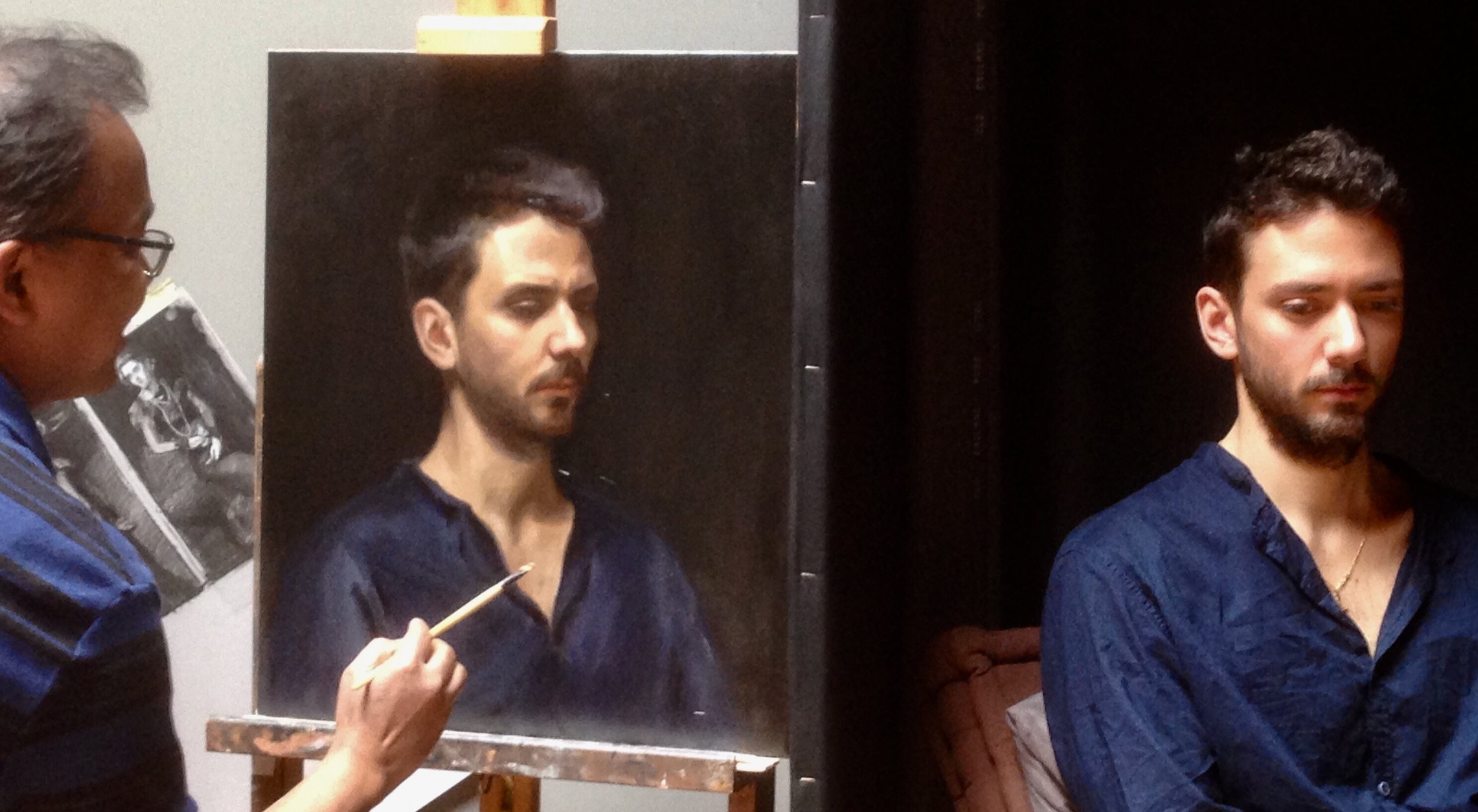
Advanced Drawing and Painting (Level-3)
Portrait Drawing and Painting, Lev-3
Intermediate to Advanced
A successful portrait embraces all of the skills from figure studies and in addition must show the character of the sitter with good likeness. Students will develop compositional studies, value studies, and color studies to aid the composition. Learning to edit ideas and choose shapes, colors, and textures that create harmony and balance will be an essential part of this course.
Students are required to produce two portraits in charcoal before progressing to the portrait in oil. A fast progressing student may be able to complete a portrait drawing with charcoal in Level-2.
Advanced Level-3 students are required to produce a self portrait and another final portrait painting with hands for their final graduation work. Students can challenge themselves to include a composition of fabric and the background setting props to express themes and expression of an idea. This final portraiture project allows the students to deal with the complexity of creating the good likeness and capturing the moment while incorporating the character of the sitter/ model in their painting. This will prepare them to become professional portraiture artists.
By the completion of Advanced Portrait Painting the student will be able to:
Aesthetically compose the setup of portraiture in its space
Draw and paint the likeness and character of the model
Demonstrate sound drawing and painting techniques
Still Life Painting, Lev-3
Still-life represents the student’s first opportunity to create original compositions, and discover their voice as an artist.
Objects must be chosen in a variety of textures and materials, beginning with simple two objects and moving to complex multiple object compositions. The student must overcome difficulties in producing a balanced composition, with regard both to light, dark, and color and the variety of uses of the brushes to achieve different effects and textures.
By the conclusion of Still life painting you will be able to:
Successfully apply drawing skills to the painting medium technique
Correctly transpose the subject’s outline, proportion and shadow shape
Achieve a sense of reality using values and temperature when working in full palette
Produce accurate color-values, drawing, sense of light, atmosphere and space
Demonstrate a sense of reality with respect to volume, weight, depth and distance.
Advanced Figure Painting, Lev-3
Intermediate to Advanced
Figure drawing and painting is an essential skill within AMAA’s academic program to obtain a complete knowledge to be a classical figurative painter.
Students learn to combine the procedures, techniques, and experience gained in the Painting program as they paint the figure in full color.
Students will develop their ability to paint figures and portraits in the interior, and try to create an aesthetic composition and expression in terms of their own painting style. This picture-making challenge will aid the student in understanding further the importance of composition and grand tonal harmony.
Advanced Figure Painting incorporates line, values, gesture, body type and proportion, and also a convincing sense of reality – anatomy, weight, and flesh.
Students are required to paint in oil 3 successful nude figures starting from Grisaille to full color palette.
By the conclusion of Advanced Figure Painting student will be able to:
Create a believable life like painting by using all the skills learnt so far
Demonstrate good understanding of color values
Demonstrate good understanding of drawing with paint
Students who complete all the required exercises receive a Certificate of Proficiency in Painting by AMAA at the end of the program.

